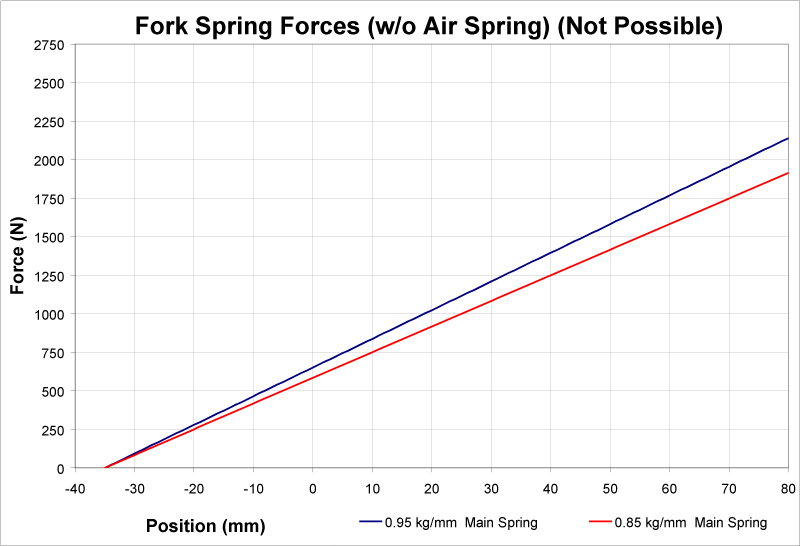Sag
We can use the concept of "Free Sag" to use the geometry attribute of sag to predict and tune the suspension attribute of spring rate. By examining how the bike compresses changing the load with and without the rider, we can determine the change in equilibrium positions of the springs. By using some basic conventions, we are able to tune for the appropriate spring rate. Just to use some imaginary numbers, lets say that the rider and gear weighs 200lbs. and the sprung weight of the bike (with gas) is 350lbs. In this case, the bike alone is 60% of the weight that the spring must hold up. Roughly 2/3 of the rider's weight will be applied to the rear wheel, so the change in the Free and Rider Sags will be greater at the rear.
The rate of the spring is critical. If desired Rider Sag is 35mm and desired rider contribution to the sag is 15mm, then that means Free Sag should be 20mm. Any spring will give you 35mm of Rider Sag, given some preload position, but only one spring (rate) will also give 20mm Free Sag with the same preload position. In other words, given specific goal numbers, only one correct spring rate exists.
Terminology varies a lot, so for this case let:
Rider Sag = Measured sag of bike and rider w/ rider and rider's gear. Free Sag = Measured sag of just the bike, no rider, no rider gear. Note - It may help to set all the slow speed damping adjusters to full open when setting sag.
SPRING RATE -
Spring Rate OK - Both free and rider sag within acceptable range.
Spring Rate too soft - Rider Sag OK, but too little or no Free Sag
Spring Rate too firm - Rider Sag OK, but too much Free Sag
SAG -
Front -
Rider Sag - 30-35mm (25-30% of Full Travel)
Free Sag - 15-20mm (60-70% of Rider Sag)
Rear -
Rider Sag - 20-30mm (race), 30-35mm (street) (25-30% of Full Travel)
Free Sag - 5-10mm (extremely light bikes use less) (15-25% of Rider Sag)
Special Cases
- "Complications in sag setting results in the use of top-out springs, such as Ohlins' use in their modern shocks and several companies are now including in their forks. These typically increase the free sag while having no effect on rider sag."GB
- Air caps on some older forks are either present to allow the gasses in a hot fork to be equalized with outside ambient pressure, or to act in a way similar to having adjustable oil height. Bleed the pressure off while performance tuning.
- "Production based bikes and road bikes need 5-10mm free sag at the rear and 15-20mm at the front. 250GP bikes will have 10-20mm at the front and nothing at the rear. 125's effectively have negative rear free sag, with the bike topping out solidly without the rider, but with 10-15mm at the front."GB
